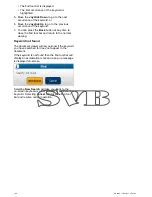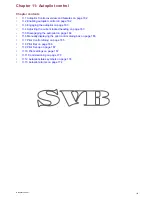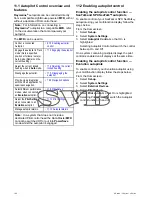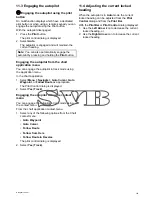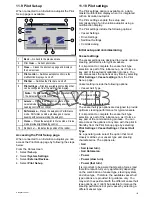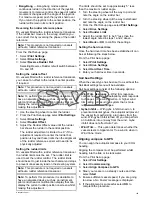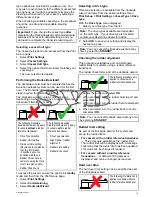
•
If you already know the hard-over time
for your
vessel’s steering system: enter this time during
the Dockside wizard procedure.
•
If you do NOT know the hard-over time
for your
vessel’s steering system: skip this step during the
Dockside wizard by selecting
SAVE
, complete the
Dockside wizard procedure. Once the wizard is
complete, calculate and adjust the hard-over time.
Checking the rudder drive
As part of the Dockside wizard, the system will check
the drive connection. Once it has completed the
check successfully, a message will appear asking if
it is safe for the system to take the helm.
During this procedure the autopilot will move the
rudder. Ensure it is safe to proceed before selecting
OK
.
When in the Dockside wizard, with the Motor Check
page displayed:
1. Center and let go of the rudder.
2. Disengage any rudder drive clutch.
3. Select
CONTINUE
.
4. Check it is safe to proceed before selecting
OK
.
For vessels
with
a rudder reference transducer,
the autopilot will now automatically move the
rudder to port and then starboard.
5. For vessels
without
a rudder reference
transducer, you will be asked to confirm the
rudder turned to port by selecting
YES
or
NO
.
6. Select
OK
if it is safe to engage the rudder in the
opposite direction.
7. You will be asked to confirm the rudder turned to
starboard by selecting
YES
or
NO
.
8. Dockside wizard is now complete, select
CONTINUE
.
Note:
If you confirmed a “NO” response for the
rudder movement to both port and starboard, the
wizard will exit. It is possible that the steering
system did not move the rudder in any direction,
and it will be necessary to check the steering
system before completing the Dockside wizard
procedure again.
Note:
If the rudder moves in the opposite direction
than expected you may need to reverse the phase
of the rudder reference unit. This can be achieved
by accessing:
Pilot Set-up > Pilot Settings >
Drive Settings > Reverse Rudder Ref
.
You can cancel Dockside wizard at any time by
pressing
STANDBY
.
Warning: Rudder check
If no rudder reference has been fitted you
MUST ensure that adequate provision is
made to prevent the steering mechanism
from impacting the end stops.
Adjusting the hard-over time
On vessels
without
a rudder reference transducer, it
is important to set the hard-over time limits correctly,
to ensure accurate autopilot operation. Hard-over
time is the time it takes the vessel’s steering system
to drive the rudder from full port to full starboard.
Before attempting the following procedure, ensure
that you’ve observed and understood the Rudder
check warning provided in this document.
The following information only
applies to vessels without a
rudder reference transducer.
1. With the autopilot in ‘Standby’ mode,
manually
turn the helm full to port
.
2. Place the autopilot in ‘Auto’ mode.
3. Using a stopwatch,
start the timer
, and then
immediately:
4. Turn 180 degrees from your current heading.
5. Once the rudder has reached the rudder limit that
was specified as part of the Dockside wizard,
stop the timer
.
6. To calculate your hard-over time, take the
measured time and double it.
7. Now access the
Hard Over Time
menu to specify
this hard-over time.
Setting the hard over time
Once the hard over time has been established it can
be set following the steps below.
From the Pilot Set-up page:
1. Select
Pilot Settings
.
2. Select
Drive Settings
.
3. Select
Hard Over Time
.
4. Enter your hard over time in seconds.
Compass linearization
With Evolution autopilot systems, when the EV unit
is first installed and powered-up, its internal compass
needs to compensate for local magnetic variations
and the earth’s magnetic field. This is achieved using
an automatic process known as linearization, which
forms an important part of the autopilot installation,
commissioning and set-up process.
Linearization
In Evolution systems, the linearization process
is performed automatically by the EV unit as
a background task when the vessel's speed is
between 3 and 15 knots, no user intervention is
required however at least a 270 degree turn is
required. The process will occur during your first
voyage with the autopilot system, and will typically
take no more than 30 minutes, but this does vary
according to the characteristics of the vessel, the
installation environment of the EV unit, and the levels
of magnetic interference at the time of conducting
the process. Sources of significant magnetic
interference may increase the time required to
complete the linearization process. Examples of
such sources include:
172
a Series / c Series / e Series
Содержание c125
Страница 2: ......
Страница 14: ...14 a Series c Series e Series ...
Страница 41: ...13 GPS receiver 14 Thermal camera 15 Wireless connection Planning the installation 41 ...
Страница 48: ...48 a Series c Series e Series ...
Страница 80: ...80 a Series c Series e Series ...
Страница 118: ...118 a Series c Series e Series ...
Страница 184: ...184 a Series c Series e Series ...
Страница 185: ...Chapter 13 Man Overboard MOB Chapter contents 13 1 Man overboard on page 186 Man Overboard MOB 185 ...
Страница 188: ...188 a Series c Series e Series ...
Страница 191: ...Chapter 15 Fuel manager Chapter contents 15 1 Fuel manager overview on page 192 Fuel manager 191 ...
Страница 206: ...206 a Series c Series e Series ...
Страница 228: ...228 a Series c Series e Series ...
Страница 290: ...290 a Series c Series e Series ...
Страница 310: ...310 a Series c Series e Series ...
Страница 340: ...340 a Series c Series e Series ...
Страница 374: ...374 a Series c Series e Series ...
Страница 422: ...422 a Series c Series e Series ...
Страница 436: ...436 a Series c Series e Series ...
Страница 462: ...462 a Series c Series e Series ...
Страница 463: ......
Страница 464: ...www raymarine com ...



